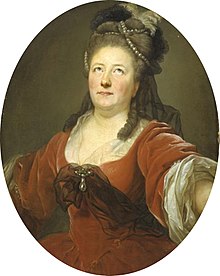
Back فريدريك صوفي سايلر Arabic فريديريك سوفى سيلير ARZ Friederike Sophie Seyler Danish Friederike Sophie Seyler German Friederike Sophie Seyler Spanish Friederike Sophie Seyler Italian Friederike Sophie Seyler NB Гензель, София Фридерика Russian Sophie Friederike Seyler Swedish
Friederike Sophie Seyler | |
|---|---|
 Friederike Sophie Seyler by Anton Graff, Kunsthalle Hamburg | |
| Born | Friederike Sophie Sparmann 1738 |
| Died | 22 November 1789 (aged 50–51) |
| Other names | Friederike Sophie Hensel |
| Occupation(s) | Actress and playwright |
| Notable work |
|
| Spouses | |
Friederike Sophie Seyler[a] (1738, Dresden – 22 November 1789, Schleswig; née Sparmann, formerly married Hensel) was a German actress, playwright and librettist. Alongside Friederike Caroline Neuber, she was widely considered Germany's greatest actress of the 18th century;[1] Gotthold Ephraim Lessing described her in his Hamburg Dramaturgy as "incontestably one of the best actresses that German theatre has ever seen."[2]
The granddaughter of the architect Matthäus Daniel Pöppelmann, she ran away from an abusive uncle under the threat of a forced marriage to join the theatre at the age of sixteen in 1754. She established herself as one of Germany's leading actresses in the 1760s and was acclaimed for her portrayal of passionate, majestic, tragic heroines. From 1767 she was professionally and personally associated with the theatre director Abel Seyler, whom she married in 1772, as the leading actress of the Hamburg National Theatre and later of the Seyler Theatre Company. With Seyler she led an itinerant life until her death, performing widely across the German-speaking realm. She also stayed for several periods at the Vienna Burgtheater between 1757 and 1772. She was associated with all the leading theatres of her era: Hamburg, Vienna, Weimar, Gotha and Mannheim.[3]
She is regarded as one of the most important female playwrights of the 18th century, and her renown as an actress contributed to the popularity of her plays. Her libretto for the opera Oberon (originally titled Huon and Amanda) was a major inspiration for Emanuel Schikaneder's libretto for the opera The Magic Flute; a lightly adapted version of Seyler's opera was the first opera performed by Schikaneder's troupe at their new theatre, the Theater auf der Wieden, and established a tradition within the Schikaneder company of fairy-tale operas that was to culminate two years later in The Magic Flute, which shared several plots, characters, and singers with Seyler's Oberon.[4] Musicologist Thomas Bauman describes Oberon as "an important impulse for the creation of a generation of popular spectacles trading in magic and the exotic. Die Zauberflöte [The Magic Flute] in particular shares many features with Oberon, musical as well as textual."[5]
Cite error: There are <ref group=lower-alpha> tags or {{efn}} templates on this page, but the references will not show without a {{reflist|group=lower-alpha}} template or {{notelist}} template (see the help page).
- ^ Susanne Kord (1993). "Tugend im Rampenlicht: Friederike Sophie Hensel als Schauspielerin und Dramatikerin" [Virtue in the Limelight: Friederike Sophie Hensel as actress and playwright]. The German Quarterly, 66(1):1–19.
- ^ Hamburgische Dramaturgie, Viertes Stück. In: Lessings Werke, published by Georg Witkowski, Vol. 4, p. 355, 1766
- ^ Cite error: The named reference
Fleigwas invoked but never defined (see the help page). - ^ Buch, David (2008) Magic flutes & enchanted forests: the supernatural in eighteenth-century musical theater (p. 293). University of Chicago Press. ISBN 0-226-07810-8.
- ^ Bauman, Thomas. "Oberon, König der Elfen." The New Grove Dictionary of Music and Musicians. Oxford University Press.